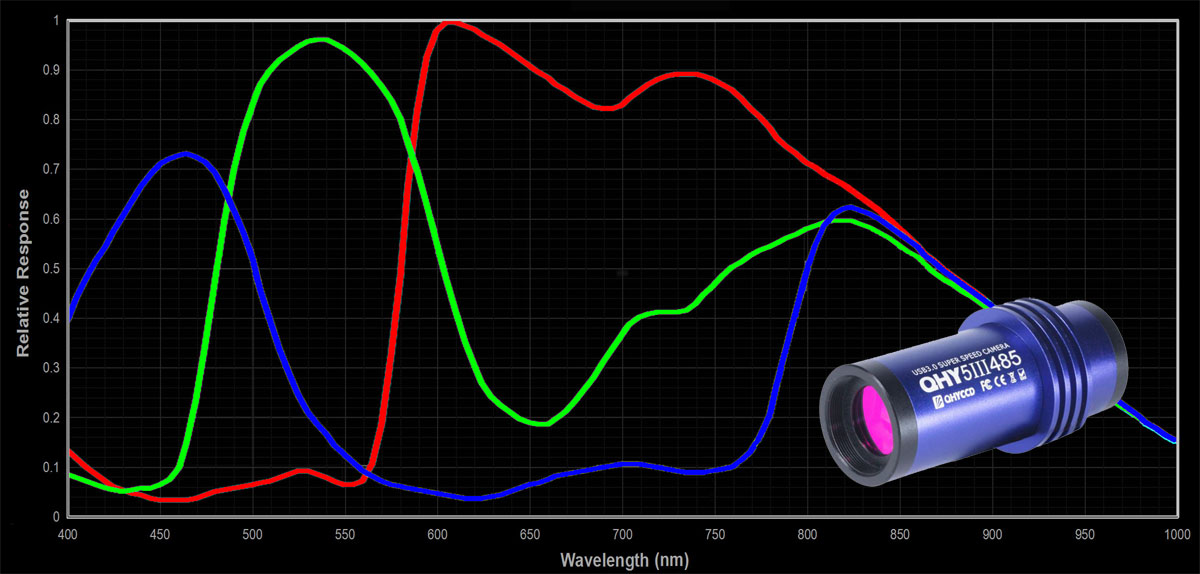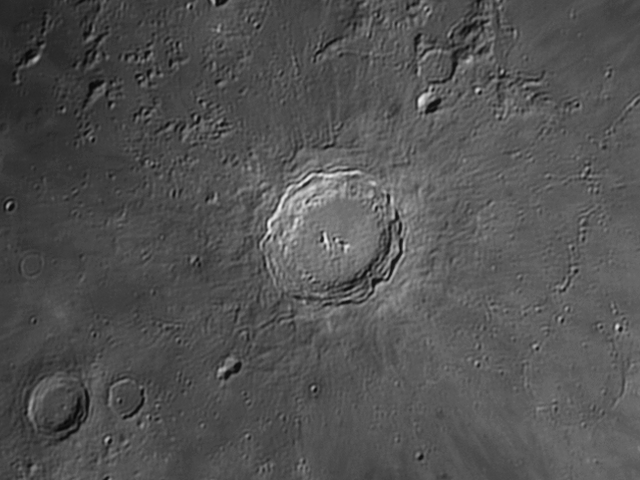Filters
The aim is to produce videos at shortest possible exposure time and fast frame rate in particular when seeing is poor and persistently rolling in clouds are disturbing. Equally important is low noise. Noise can be reduced by choosing the lowest feasable gain and a large number of frames to stack. Naturally, imaging the Moon at good seeing is the best guarantor of success.
Infrared pass filters compensate a lot for poor seeing but need longer exposure times as the camera's infrared response is lower than its visual color response. In case of the ASI290MM, the exposure time with an IR640nm pass filter is about half that of an IR740nm filter -- a significant benefit when seeing is not that bad. When using infrared pass filters on color cameras you would typically record in monochrome.
Infrared filters are used with monochrome cameras or when recording in monochrome with color cameras. Because the resolution in infrared diminishes with increasing wavelength, it is advisable to choose the filter in accordance with seeing. A red filter is often used when seeing is good or even a green filter when seeing is exceptional. Both provide sharper and more detailed images at short exposure times. The unwanted effect of edge diffraction (Rayleigh criterion: 1.22 * wavelength/aperture) increases with increasing wavelength, in that imaging in visual is the better choice when seeing is good and the atmosphere calm. The Gibbs effect, ringing around craterlet walls, occurs where sharpening messes up sharp transitions from dark to light.
 Lunar landscape captured during calm air with an IR640nm filter. A green filter would have provided a bit more resolution. Celestron C8, 1.6x barlow and ASI290MM camera.
Lunar landscape captured during calm air with an IR640nm filter. A green filter would have provided a bit more resolution. Celestron C8, 1.6x barlow and ASI290MM camera.
Quality IR-cut filters for recording in visual wavelengths pass more than 95% of the light hence hardly sacrificing exposure time. It is a dance on a rope. Either you record in visual light resulting in the shortest possible exposure times and fastest frame rates, or in infrared with longer exposures and slower frame rates, but less prone to poor seeing. When your time and clouds allow, image in both domains and select the keepers after post-processing.

ASI462MC/QHY5III462C
Response of the ASI462MC/QHY5III462C color cameras. The response in near infrared is higher than in color, a unique characteristic which helps reduce exposure times for infrared imaging.
ASI290MM/QHY5III290M
Response of the ASI290MM/QHY5III290M monochrome cameras. The response in near infrared drops past 600nm and is around 50% at 850nm. However, the response is still high with typical IR-pass filters of 640 to 740nm.

QHY5III485C
In November 2020, QHYCCD has launched its QHY5III485C, an 8.3 megapixels 4K color camera with 3840×2160 pixels, 2.9µm each, coring the 11.2 x 6.2mm dimensioned Sony IMX485 sensor. It is basically QHY's QHY5III290C but with four times the chip area resulting in twice the field of view. In 2x2 binning mode the cell size doubles to 5.8µm while still providing HD resolution. An internal 128MB DDR3 cache helps avoid frame drops.
Neptune-C II
Available since April 2021, the Neptune-C II houses the IMX464 sensor which is identical to the IMX462, but twice as large by area. The sensor chip measures 7.9 x 4.5mm which translates to 2712 x 1538 pixels, given a pixel size of 2.9µm. The manufacturer, Player-One Astronomy, has incorporated generous 256MB DDR3 cache memory which helps avoid frame drops.
The curves should be taken with a grain of salt as for most cameras the accurate relative response, also specified as quantum efficiency, QE, is unconfirmed.
Test with ASI290MM...
This equally stacked and processed monochrome image trio compares the results with various filters under turbulent air. Test equipment: ASI290MM camera set to mono-8 and 10-bit ADC, Ø150mm f5 Newtonian with 2x barlow (FL=1500mm, f10). Obviously, the differences are subtle. Short exposure times freeze the frames while infrared is less prone to seeing. The IR640nm pass filter allows short exposure times while contributing the infrared advantage. Click on an image to view its full size.




